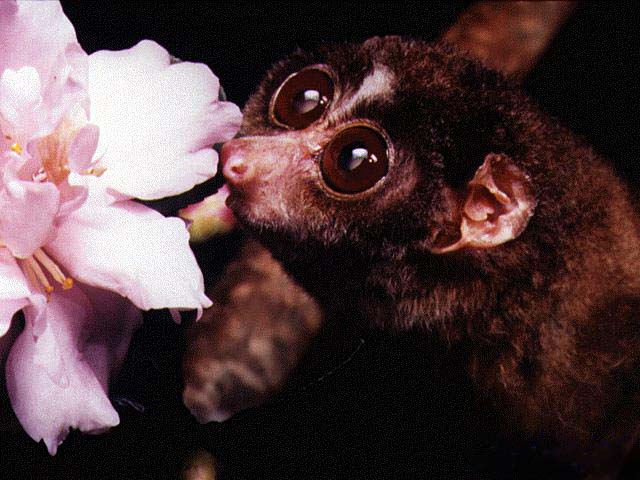- Red Slender Loris
Taxobox
name = Red Slender LorisMSW3 Groves|pages=122]

image_width = 230px
status = EN
trend = down
status_system = iucn3.1
status_ref = IUCN2006|assessors=Participants of CBSG CAMP workshop: Status of South Asian Primates (March 2002)|year=2004|id=12375|title=Loris tardigradus|downloaded=2006-05-09 Database entry includes justification for why this species is endangered]
regnum =Animal ia
phylum = Chordata
classis =Mammal ia
ordo =Primate s
familia =Lorisidae
genus = "Loris"
species = "L. tardigradus"
binomial = "Loris tardigradus"
binomial_authority = (Linnaeus, 1758)The Red Slender Loris ("Loris tardigradus") is a small, nocturnal
prosimian native to therainforest s ofSri Lanka . This is #6 of the 10 focal species and #22 of the 100 EDGE animal species worldwide considered the most Evolutionarily Distinct and Globally Endangered. [cite web | work = [http://www.edgeofexistence.org/home.asp EDGE] | accessdate = 2007-08-13 | url = http://www.edgeofexistence.org/species/species_info.asp?id=22 | title = Slender loris] Two subspecies have been identified, "L. t. tardigradus" and "L. t. nycticeboides".Physical description
This small, slender
primate is distinguished with large forward facing eyes used for precise depth perception, long slender limbs, a well developed index finger, the absence of tail, and large prominent ears, which are thin, rounded and hairless at the edges. The soft dense fur is reddish-brown color on the back and the underside is whitish-grey with a sprinkling of silver hair. Its body length on average is 7-10 in. (17.5-26 cm), with an average weight of a mere 3-13 oz.(85-350g). Thisloris has a four way grip on each foot. The big toe opposes the other 4 toes for a pincer like grip on branches and food. It has a dark face mask with central pale stripe, much like theslow loris es.Behavior
The Red Slender Loris favors lowland
rainforest s (up to 700 m in altitude), tropical rainforests and inter-monsoon forests of the south western wet-zone of Sri Lanka. Masmullah Proposed Forest Reserve harbors one of few remaining Red Slender Loris populations, and is considered abiodiversity hotspot . The most common plant species eaten was "Humboldtia laurifolia ", occurring at 676 trees/ha, with overall density at 1077 trees/ha. "Humboldtia laurifolia" is vulnerable and has a mutualistic relationship with ants, providing abundant food for lorises. [cite journal | author = K. Anne-Isola Nekaris, Wasantha K. D. D. Liyanage, Saman N. Gamage | month = July | year = 2005 | journal = Mammalia | volume = 69 | issue = 2 | pages = 201–210 | doi = 10.1515/mamm.2005.017 | title = Influence of forest structure and composition on population density of the red slender loris "Loris tardigradus tardigradus" in Masmullah proposed forest reserve, Sri Lanka] Reports from the 1960s suggest that it once also occurred in the coastal zone, however it is now thought to be extinct there.The Red Slender Loris differ from its close relative the
Gray Slender Loris in its frequent use of rapid arboreal locomotion. It forms small social groups, containing adults of both sexes as well as young animals. This species is among the most social of the nocturnal primates. During daylight hours the animals sleep in groups in branch tangles, or curled up on a branch with their heads between their legs. The groups also undertake mutual grooming and play at wrestling. The adults typically hunt separately during the night. They are primarilyinsectivorous but also eat bird eggs, berries, leaves, buds and occasionallyinvertebrate s as well asgecko s andlizard s. To maximize protein and nutrient uptake they consume every part of their prey, including the scales and bones. They make nests out of leaves or find hollows of trees or a similar secure place to live in.Reproduction
Females are dominant. The female reaches her sexual maturity at 10 months and is receptive to the male twice a year. This species mates while hanging upside down from branches; individuals in captivity will not breed if no suitable branch is available. The gestation period is 166-169 days after which the female will bear 1-2 young which feed from her for 6-7 months. The lifespan of this species is believed to be around 15-18 years in the wild.
Threats
This slender loris is an endangered species. Habitat destruction is a major threat. It is widely trapped and killed for use in supposed remedies for eye diseases and also for use as laboratory animals. [cite web | author = Benders-Hyde, Elisabeth | year = 2002 | accessdate = 2007-07-24 | url = http://www.blueplanetbiomes.org/slender_loris.htm | title = Slender Loris] Other threats include: electrocution on live wires, road accidents and the pet trade. [cite journal | author = K. A. I. Nekaris, J. Jayewardene | year = 2004 | title = Survey of the slender loris (Primates, Lorisidae Gray, 1821: Loris tardigradus Linnaeus, 1758 and Loris lydekkerianus Cabrera, 1908) in Sri Lanka | journal = Journal of Zoology | volume = 262 | issue = 4 | pages = 327–338 | doi = 10.1017/S0952836903004710]
Conservation
The Red Slender Loris was identified as one of the top-10 "focal species" in 2007 by the Evolutionarily Distinct and Globally Endangered (EDGE) project. [Cite news | title = Protection for 'weirdest' species | url = http://news.bbc.co.uk/2/hi/science/nature/6263331.stm | date = 2007-01-16 | accessdate = 2007-05-22 | work =
BBC ]In popular culture
References
External links
*ARKive - [http://www.arkive.org/species/GES/mammals/Loris_tardigradus_and_Loris_lydekkerianus/more_info.html images and movies of the slender loris "(Loris tardigradus and Loris lydekkerianus)"]
Wikimedia Foundation. 2010.
